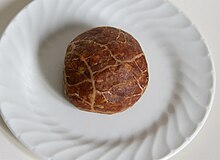Saumaise
The Saumaise (also pig Maise ) is a (chopped) of finely minced salt pork shaped patties provided with a pig network is wrapped. It is an Austrian specialty from the Waldviertel region , but also from Carinthia and is listed in the register of traditional foods . Traditionally, Saumaisen were made at house slaughter and also placed on the peasant table during the saute dance .
designation
The term maise may be traced back to the Old and Middle High German word meisilī , which means small cuts .
preparation
For the traditional production of Saumaisen in Austria , lean and fat portions of mostly smoked pork or salted meat are used. During preparation, the meat parts are turned through the meat grinder with onions and garlic and seasoned with paprika powder , lemon peel , salt and pepper . The mass is then formed into patties and broken into pieces of pork net. Before consumption, saumans are boiled or fried in the oven and served with various side dishes.
In addition to the traditional variant, there are different, region-specific recipes throughout Austria. All styles have in common that the dumpling-like mass is wrapped in a piece of pig's net.
Carinthian variant
In Carinthia, pork head meat or pork lung and heart is used. The minced innards are mixed with barley , dumpling bread and other ingredients and formed into patties. According to linguists, the Carinthian name Maischerln may have come back into German via the Slovene language .
Dissemination, supplements
Saumaisen traditionally produced on the farm are also available in Austria in down-to-earth gastronomy and in the commercial sector of sausage production. They are eaten hot. As side dishes cooked are sauerkraut , potatoes , mashed potatoes or Waldviertler potato dumplings usual.
Web links
Individual evidence
- ↑ a b c d Wolfgang Wernert, Daniela Trenker: Saumaise. In: Register of Traditional Foods . September 11, 2019, accessed April 23, 2020 .
- ↑ a b c Traditional Saumaise on the website of the Federal Ministry of Agriculture, Regions and Tourism
